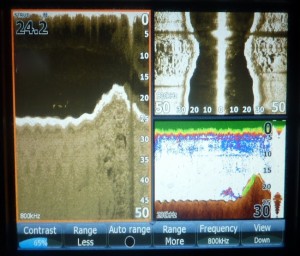 Back when I was a kid tramping through the woods of East Tennessee, I looked for the underground dens of rabbits, chipmunks and woodchucks. Now days, I’m stalking fish instead of varmints, but I’m still hunting for hidey-holes. It’s the time of year when Chesapeake Bay striped bass hunker down in deep, warm-water hideouts. It takes patience and persistence to catch them but if you aggravate them long enough, you can sometimes get them to bite. The trollers are still picking off a few big cows around the channels, but it’s tough to get isolated fish on a jig. From now until the first of the year I’ll be fishing around the bridges and in the deeper water around other submerged structure looking for holed-up rockfish. Read More!
Back when I was a kid tramping through the woods of East Tennessee, I looked for the underground dens of rabbits, chipmunks and woodchucks. Now days, I’m stalking fish instead of varmints, but I’m still hunting for hidey-holes. It’s the time of year when Chesapeake Bay striped bass hunker down in deep, warm-water hideouts. It takes patience and persistence to catch them but if you aggravate them long enough, you can sometimes get them to bite. The trollers are still picking off a few big cows around the channels, but it’s tough to get isolated fish on a jig. From now until the first of the year I’ll be fishing around the bridges and in the deeper water around other submerged structure looking for holed-up rockfish. Read More!
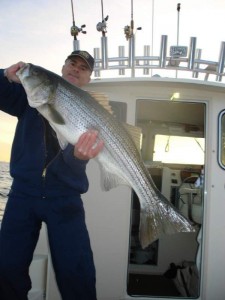 Maybe I’m getting better, but more likely I just got lucky. Either way, I called this last pattern change pretty close. As the water cools, big fish move closer to the main channel of the Chesapeake Bay. There’s still plenty of smaller fish in the rivers and the nearby flats, but since it’s late November and the season for trophies, it’s time to lock in on the channel. Here are two good reasons: Number one – water temperature. Striped bass prefer water that is warmer than 50 degrees. Surface temperatures right now in most of the Maryland section of the Chesapeake Bay are in the low 50s. Since the deeper water near the channel can be ten degrees warmer than it is in the rivers, stripers will stay closer to their comfort zone. You’ll see them holding very close to the bottom on the fish finder. They will still move up shallow to eat, but they’ll go right back to the deeper water to rest between feeding frenzies.
Maybe I’m getting better, but more likely I just got lucky. Either way, I called this last pattern change pretty close. As the water cools, big fish move closer to the main channel of the Chesapeake Bay. There’s still plenty of smaller fish in the rivers and the nearby flats, but since it’s late November and the season for trophies, it’s time to lock in on the channel. Here are two good reasons: Number one – water temperature. Striped bass prefer water that is warmer than 50 degrees. Surface temperatures right now in most of the Maryland section of the Chesapeake Bay are in the low 50s. Since the deeper water near the channel can be ten degrees warmer than it is in the rivers, stripers will stay closer to their comfort zone. You’ll see them holding very close to the bottom on the fish finder. They will still move up shallow to eat, but they’ll go right back to the deeper water to rest between feeding frenzies.
The second reason to fish near the channel is bait. Larger fish want bigger bait. The most common baitfish of any consequence in the Bay right now is menhaden. Since they migrate toward warmer water just like rockfish, by late November they are well on their way toward their comfort zones farther south. That means there is less and less bait in the upper reaches of the Bay and the biggest concentrations of menhaden are now near the channel. That’s perfect conditions for big stripers because they can hang out in the deeper warmer water and still ambush big bait. That doesn’t mean they’ll bite anything you throw at them though. Well, maybe the smaller fish will, but there’s a secret to getting the trophies. Read More!
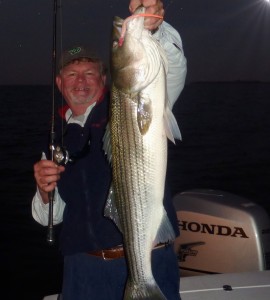 There’s a blue moon shining
There’s a blue moon shining
When I am reminded of all we’ve been through
Such a blue moon… shining
Does it ever shine down on you? -Nanci Griffith
I guess you could say my wife and I met on a blue moon. It was at least a rare occasion, one that I’ll never regret because, among other great things, it ultimately led me to the Chesapeake Bay. There’s some discussion about what makes a moon blue these days. The modern interpretation is that the blue moon is the second full moon in any given month, but there’s an older interpretation I like better. There are normally three full moons in each season whether spring, summer, fall, or winter, but sometimes, rarely, there is an extra full moon. Farmers and fishermen who plan their lives by the seasons refer to the usual full moon cycles in a three-name seasonal sequence – for example the early summer moon, mid summer moon, or late summer moon. The late moon is always the last of the season, so when that rarely occurring extra full moon comes along, it is left without a name. We call it the blue moon. That makes tonight, Sunday November 21st the blue moon of fall 2010. You can read more about it in this Space.com article. Since the phases of the moon drastically influence the tidal currents in the Chesapeake Bay, I pay very close attention. Read More!
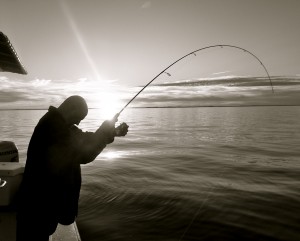 Whenever someone asks me how I feel about making striped bass a gamefish in Maryland, my answer is always the same – they already are. Light tackle anglers fish for striped bass almost the same as we would for black bass, trout, crappie, or walleye. Most of us use the same equipment. The only real difference I can see is that a few influential people in the mid-Atlantic find it profitable to commercially harvest stripers. I never heard of striped bass on a restaurant menu until I moved to Maryland. In fact, people in other parts of the country don’t consider them particularly good to eat. I cook them occasionally, but is any fish tasty enough to deserve all the controversy that surrounds striped bass? The biggest thing they have going for them is that they’re fun to catch and they’re pursued by more recreational anglers than any other species. In my book, that spells gamefish. Last week the Atlantic States Marine Fisheries Commission (ASMFC) voted down several amendments which would have increased the commercial harvest of striped bass. Maryland voted for no increase. That’s a positive sign from a state that traditionally harvests and sells more than its fair share, but it’s no reason to celebrate. Maintaining the status quo is just more bad news for the fish. Read More!
Whenever someone asks me how I feel about making striped bass a gamefish in Maryland, my answer is always the same – they already are. Light tackle anglers fish for striped bass almost the same as we would for black bass, trout, crappie, or walleye. Most of us use the same equipment. The only real difference I can see is that a few influential people in the mid-Atlantic find it profitable to commercially harvest stripers. I never heard of striped bass on a restaurant menu until I moved to Maryland. In fact, people in other parts of the country don’t consider them particularly good to eat. I cook them occasionally, but is any fish tasty enough to deserve all the controversy that surrounds striped bass? The biggest thing they have going for them is that they’re fun to catch and they’re pursued by more recreational anglers than any other species. In my book, that spells gamefish. Last week the Atlantic States Marine Fisheries Commission (ASMFC) voted down several amendments which would have increased the commercial harvest of striped bass. Maryland voted for no increase. That’s a positive sign from a state that traditionally harvests and sells more than its fair share, but it’s no reason to celebrate. Maintaining the status quo is just more bad news for the fish. Read More!
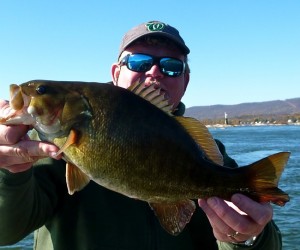 I had to pull a night shift at work this week, so I decided to reset my circadian clock with an early morning of smallmouth fishing on the Susquehanna river. Last July, I invited Bill Montgomery to join me for a Chesapeake Bay top-water striper trip near Poplar Island. Bill and I hit it off after finding we shared interests in both fishing and acoustic music. Bill returned my fishing favor by inviting me up to Pennsylvania to see one of his favorite bass spots. He fishes occasionally with his friend Dennis Mongold who is a smallmouth bass guide specializing in this section of the Susquehanna. I met them near Harrisburg where we loaded up in Dennis’s custom made aluminum jon-boat. The boat is specially outfitted for fishing this section of the rocky river. Dennis has his jet-drive outboard mounted on a hydraulic lift so he can adjust the draft for very shallow water. The bottom of the boat is coated with hard plastic so it can easily skim over the rocks. I’ve done a lot of river fishing, but this is the first time I’ve been on a boat running thirty miles per hour in four inches of water. I admit I was a little unnerved! Read More!
I had to pull a night shift at work this week, so I decided to reset my circadian clock with an early morning of smallmouth fishing on the Susquehanna river. Last July, I invited Bill Montgomery to join me for a Chesapeake Bay top-water striper trip near Poplar Island. Bill and I hit it off after finding we shared interests in both fishing and acoustic music. Bill returned my fishing favor by inviting me up to Pennsylvania to see one of his favorite bass spots. He fishes occasionally with his friend Dennis Mongold who is a smallmouth bass guide specializing in this section of the Susquehanna. I met them near Harrisburg where we loaded up in Dennis’s custom made aluminum jon-boat. The boat is specially outfitted for fishing this section of the rocky river. Dennis has his jet-drive outboard mounted on a hydraulic lift so he can adjust the draft for very shallow water. The bottom of the boat is coated with hard plastic so it can easily skim over the rocks. I’ve done a lot of river fishing, but this is the first time I’ve been on a boat running thirty miles per hour in four inches of water. I admit I was a little unnerved! Read More!
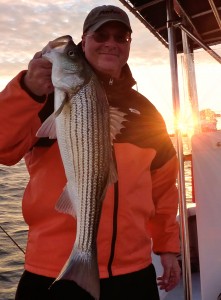 What has been will be again,
What has been will be again,
What has been done will be done again;
There is nothing new under the sun -Ecclesiastes 1:9
Since Candy Thomson published an article about my favorite jigging technique in today’s Baltimore Sun, I thought I might talk about it a little more. First, thanks to Candy for the nice write-up. She had originally planned to fish with us, but unfortunately broke a finger in a kayak accident a couple of days before. She decided to come along anyway and it was great having her, Joe, and Colin on Thunder Road for a fun evening of catching. I’m a big fan of Candy’s Outdoors Girl blog. I don’t always agree with her, but I never miss an entry. There’s no question that, despite the splint she’s wearing lately, she has her finger squarely on the pulse of outdoor issues in Maryland.
I’ll start this article by stating the obvious in that casting artificial lures for stripers using outfits made for freshwater black bass is nothing new – my father taught me to catch stripers using bass lures when I was very young. I had never heard of using heavy duty saltwater trolling gear for rockfish until I moved from Tennessee to Maryland. I was amazed and somewhat amused the first time I saw a twenty-five rod planer board trolling spread. Read More!


